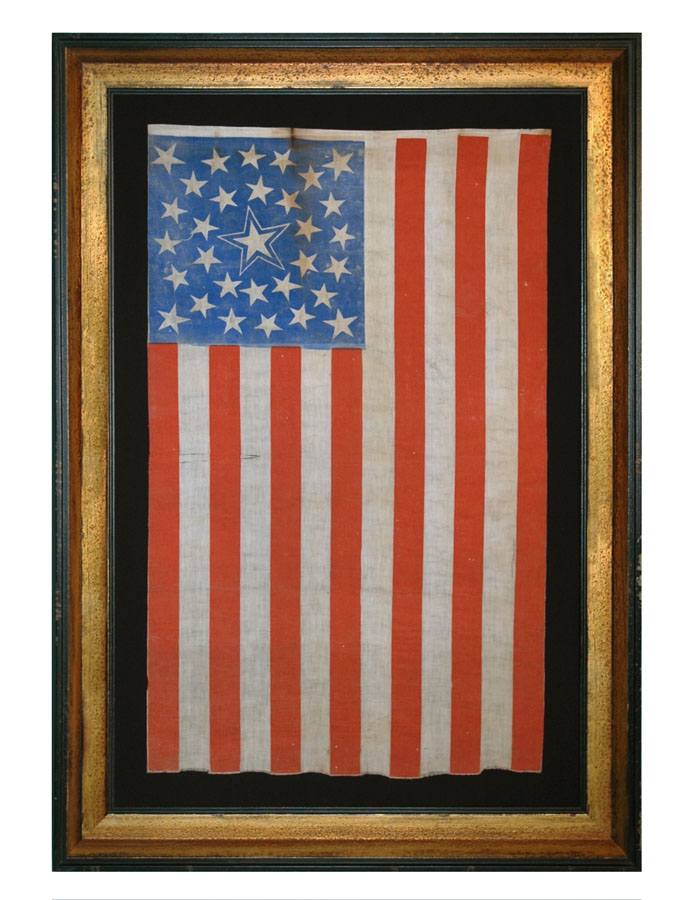
| |
31 STARS IN A MEDALLION CONFIGURATION WITH A LARGE HALOED CENTER STAR, ON A CORNFLOWER BLUE CANTON, WITH AND TOMATO RED STRIPES, CALIFORNIA STATEHOOD, PRE-CIVIL WAR (1850-1858) |
|
| Available: |
Sold |
| Frame Size (H x L): |
32.5" x 46.75" |
| Flag Size (H x L): |
22.5" x 36.75" |
|
| Description....: |
|
31 STARS IN A MEDALLION CONFIGURATION WITH A LARGE HALOED CENTER STAR, ON A CORNFLOWER BLUE CANTON, WITH AND TOMATO RED STRIPES, CALIFORNIA STATEHOOD, PRE-CIVIL WAR (1850-1858):
31 star American national flag, printed on cotton, with a medallion configuration of stars. This consists of a large center star, surrounded by two consecutive wreaths of small stars, with a slightly larger flanking star in each corner of the canton. California became the 31st state in 1850, ushered in on the heels of the 1849 Gold Rush.
Note the striking, unusual shades of tomato red and cornflower blue. There were no official qualifications until 1912, so a wide spectrum of hues appear in early examples. Attractive colors such as these are not the norm and so are particularly desired. The orange coloration of the stripes results from the use of cochineal to create the red pigment and is typical of many block-printed flags made during and prior to the 1876 centennial of our nation's independence.
Also note how the center star isn't solid, but is silhouetted by a white line that flag collectors have termed a "halo". The bold style of this star places it among the most beautiful 19th century designs. Although the name of the company that produced these flags with a haloed center star is not known, it appears to have made five other star counts using this style: 30, 34, 35, 36 and 42. Because printed parade flags did not exist before the 26-star era (1837-1845), and because few private individuals flew the Stars & Stripes before the Civil War (1861-1865), this particular maker would have been among the first to produce printed flags.
The 31 star flag was official from 1851-1858. Flags made prior to the Civil War are extremely rare, comprising less than one percent of 19th century flags that exist in the 21st century. Prior to the Confederate attack on Fort Sumter, the Stars & Stripes was simply not used for most of the same purposes we employ it in today. Private individuals did not typically display the flag in their yards and on their porches. Parade flags didn't often fly from carriages and horses. Places of business rarely hung flags in their windows. Private use of the national flag rose swiftly during the patriotism that surrounded the Civil War, then exploded in 1876.
Even the military did not use the flag in a manner that most people might think. Most people would be surprised to learn that the infantry wasn't authorized to carry the Stars & Stripes until the 1830's, and even then did not often exercise the right, because it was neither required nor customary. The primary purpose before the Mexican War (1846-48) was to mark ships on the open seas. While the flag was used to mark garrisons and government buildings, the flags of ground troops were often limited to the flag of their own regiment and a federal standard, which was a blue flag with an eagle serving as its central device under an arch of stars.
Mounting: The flag has been placed in its correct vertical position, with its canton in the upper left. It has been hand-stitched to 100% cotton twill, black in color. The background fabric was washed to remove excess dye, and an acid-free agent was added to the wash to set the dye. The flag was then placed in a contemporary, black painted, hand-gilded and distressed Italian molding. Spacers keep the textile away from the glazing, which is U.V. protective glass.
Condition: There is minor staining and a minor tear resulting from rust on a tack that held the flag to a wooden staff along the hoist end, adjacent to the canton. There is very minor staining elsewhere and there is minor fabric loss from use along the fly edge. There is a piece of cotton in the shape of an elongated "V" in the top center of the stripe area that separated from the rest of the flag. This was stitched down in place during the mounting process. There is a small lateral tear in the last white stripe and there are a couple of pinprick-sized hole in the 3rd white stripe. Due to the great rarity and desirability of pre-Civil War examples, almost any condition is warranted. And among flags of this period, this is a particularly strong example due to its great colors. |
|
|
|
| Collector Level: |
Advanced Collectors and the Person with Everything |
|
| Flag Type: |
Parade flag |
|
| Star Count: |
31 |
|
| Earliest Date of Origin: |
1850 |
|
| Latest Date of Origin: |
1858 |
|
| State/Affiliation: |
California |
|
| War Association: |
1777-1860 Pre-Civil War |
|
| Price: |
SOLD |
|
| |
Views: 3059 |
|
|
|

